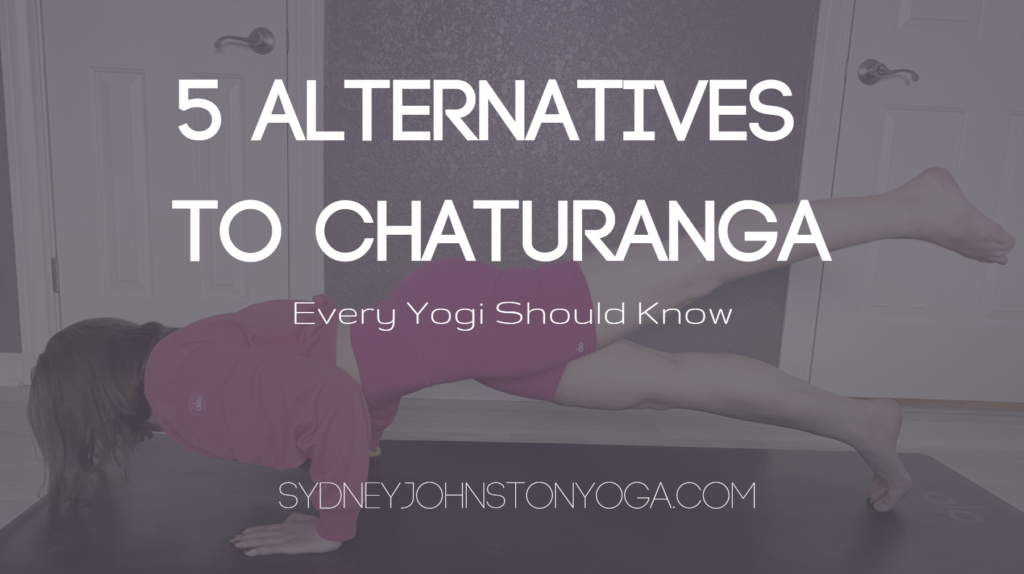Chaturanga to updog to downdog is a well-known half-sun-salute that marks the beginning and end of each flow within a hatha or vinyasa practice. It’s even used in Ashtanga yoga.
The problem, however, is that chaturanga is one of the most difficult yoga poses to do correctly. And when performed incorrectly, it is very dangerous (high risk for an acute injury) and will likely lead to chronic injuries over time (think back, shoulder, and wrist issues). Updog is also dubious because of the temptation to overarch the lower back and throw the head too far back, crunching the neck. PS: I offer private lessons to help you perfect your chaturanga flow! Scroll to the end of this article or click here to learn more.
Chaturanga-updog-downdog can be a lovely goal to work toward, but it is by no means the end-all be-all of yoga. Nor is it even the most beneficial sequence for strengthening the body.
To prioritize safety, chaturanga-updog-downdog should only be practiced when the practitioner is capable of doing so with proper alignment. So what should you do when the teacher says “vinyasa flow” if you’re not ready yet?
Here are 5 alternatives to chaturanga-updog-downdog that all upgrade the safety of vinyasa flow. Each one provides a unique restorative or challenging quality, so feel free to experiment and choose the one based on your mood and practice. Note that for each alternative sequence, the ending point would be downdog or tabletop – so you would transition from the last pose shown into downdog/table top, and then begin the next flow that follows your “vinyasa flow”.
1) Cat-cow

For this flow, you’ll come to tabletop and move through a round of cat-cow, then come back to tabletop or downdog (yogi’s choice).
Sequencing:
- Chaturanga → tabletop
- Updog → cow pose (pictured on left)
- Downdog → cat pose (pictured on right)
- End in tabletop or downdog (yogi’s choice)
Benefits of this variation:
- Improves spinal mobility
- Strengthens core muscles (keep core engaged and ribs knitted together in both cat and cow!)
- Prevents overarching of the neck
2) Tabletop to Child’s Pose (Balasana)

This variation is a wonderful rest between challenging flows in a hatha or vinyasa sequence.
Sequencing:
- Chaturanga → tabletop (pictured on left)
- Updog/downdog → child’s pose (pictured on right)
- End in tabletop or downdog (yogi’s choice)
Benefits of this variation:
- Gives wrists a chance to rest (whereas they are working overtime in the chaturanga-updog-downdog flow!!)
- Stretches and lengthens the hamstrings (in child’s pose)
- Promotes introspection and awareness of the present moment
- Allows the breathing to return to a controlled ujjayi or other form of pranayama
3) Tabletop to Puppy Pose (Anahatasana)

This flow has many of the same benefits as the tabletop to child’s pose variation. Additionally, puppy pose provides an unparalleled heart-opening and arm stretch, and also stimulates the third eye (ajna chakra) which helps to draw the awareness inward and to the present moment.
Sequencing:
- Chaturanga → tabletop (pictured on left)
- Updog/downdog → puppy pose (pictured on right)
- End in tabletop or downdog (yogi’s choice)
Benefits of this variation:
- Gives wrists a chance to rest
- Heart-opening
- Stretches the upper arms and shoulders
- Promotes introspection and awareness of the present moment
- Allows the breathing to return to a controlled ujjayi or other form of pranayama
4) Plank to Cobra (Bhujangasana)

This is what my YTT taught as a preferred alternative to chaturanga and it is what I practice the majority of the time in my personal practice. Plank strengthens the same muscles as chaturanga, and cobra strengthens more muscles than updog does because you are powering your cobra using the back muscles (whereas the back muscles are largely inactive in updog).
Sequencing:
- Chaturanga → plank (pictured on left)
- Updog → cobra (pictured on right)
- End in tabletop or downdog (yogi’s choice)
Benefits:
- Plank pose strengthens core and arm muscles
- Cobra strengthens back muscles (whereas updog does not strengthen, since the weight is in the wrists, cobra by contrast strengthens the back muscles because those are pulling you up into your cobra – not pushing into the hands)
- Less strain on wrists
- Reduces risk of overarching the back and neck
5) Knees, Chest, Chin

Knees, chest, chin is a traditional hatha flow component of the sun salute (surya namaskar). I love this alternative to chaturanga, but it should be practiced carefully to avoid crunching the neck in the ‘chest’ portion.
Sequencing:
- Chaturanga → plank (pictured on far left)
- Updog → cobra (pictured on far right)
- End in tabletop or downdog (yogi’s choice)
Benefits:
- Plank pose strengthens core and arm muscles
- Cobra strengthens back muscles
- Provides a different and unique pacing for the inhales and exhales
- Fluid-like motion (may feel better than chaturanga-updog-downdog, depending on your body)
- Heart-opening
- Strengthens arms
If you’re unfamiliar with knees, chest, chin and interested in learning, here is a video tutorial I highly recommend:
These are just five of the many possible alternatives to chaturanga. Even if chaturanga is a regular part of your practice, I suggest trying these variations (or coming up with your own!) because each offers a unique quality or benefit that the traditional chaturanga-updog-downdog flow does not.
RELATED: If chaturanga is a part of your practice, or you want to begin practicing chaturanga…

Learn more about private classes on my Classes and Schedule page!

